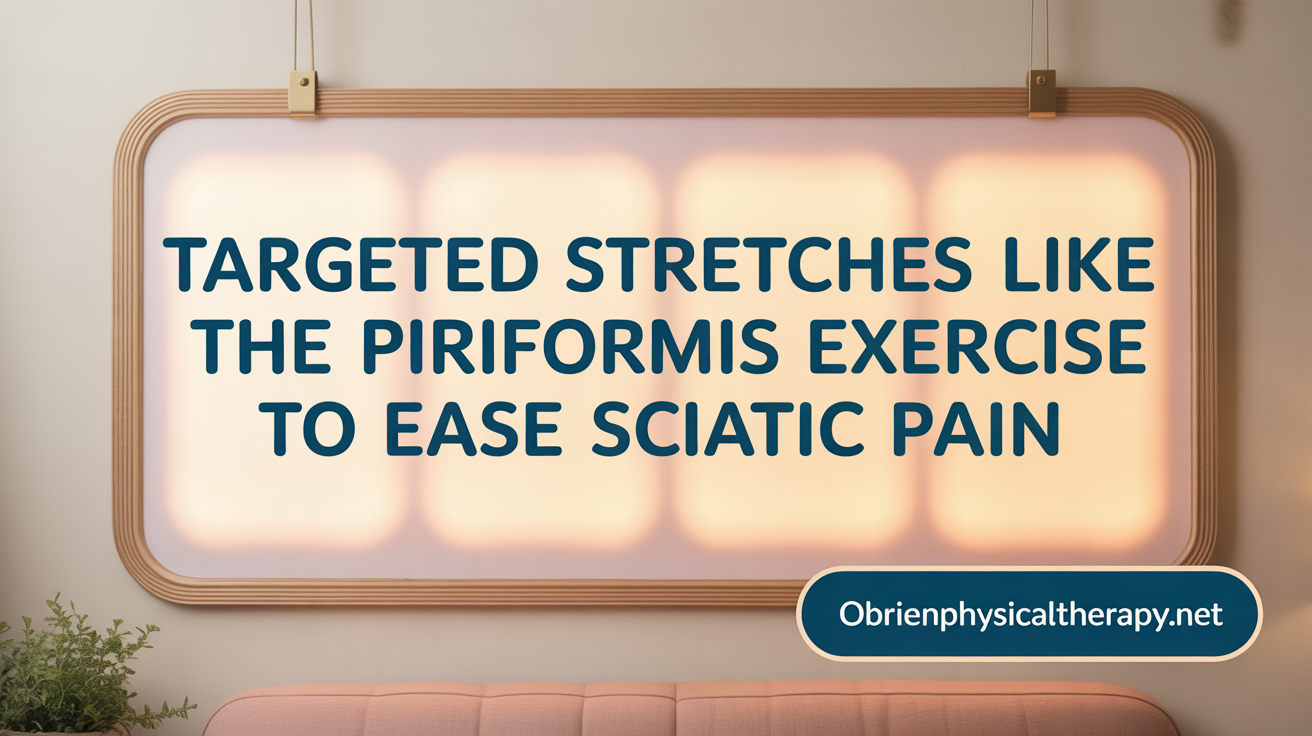Understanding Sciatica and the Role of Physical Therapy
Sciatica is a common condition characterized by pain radiating along the sciatic nerve, often from the lower back through the buttock and down the leg. This pain can range from mild discomfort to severe, debilitating symptoms accompanied by numbness, tingling, or muscle weakness. While causes of sciatica vary from mechanical compression to inflammation, physical therapy stands out as a leading non-invasive treatment option. It offers personalized approaches to relieve pain, restore mobility, and prevent recurrence through therapeutic exercises, manual techniques, and lifestyle modifications tailored to individual needs.
Understanding Sciatica: Symptoms, Causes, and Diagnosis

What are the common symptoms and causes of sciatica?
Sciatica is characterized by pain that radiates down the back of the leg, which can vary in presentation from a dull ache to intense, shooting, or burning sensations. Often, patients experience numbness, tingling, or muscle weakness along the nerve pathway. These symptoms are typically caused by pressure or irritation of the sciatic nerve, which may result from herniated discs, bone spurs, or muscle spasms pushing against the nerve.
The causes of sciatica fall into two main categories: mechanical and inflammatory. Mechanical causes include structural issues like herniated discs, spinal stenosis, or degeneration of the lumbar spine that physically compress the nerve. Inflammatory causes involve swelling or swelling-related compression from conditions such as injury, pregnancy, infection, or autoimmune diseases.
Diagnosing sciatica involves a comprehensive clinical assessment and physical examination. While imaging tests like MRI or CT scans are not always necessary initially, they become important if there are red flag symptoms, like severe weakness, loss of bladder or bowel control, or if symptoms persist beyond a few weeks. Proper diagnosis is vital, as it guides targeted therapies and helps in excluding serious underlying conditions.
What are some typical causes, including mechanical and inflammatory origins?
The most common mechanical origin of sciatica is pressure from herniated discs or bone spurs compressing the nerve roots. Other causes include degenerative disc disease, spinal stenosis, and spondylolisthesis.
Inflammatory causes, while less frequent, include swelling caused by injury, infections, or conditions like pregnancy that increase pressure within the pelvis. Autoimmune inflammatory diseases such as rheumatoid arthritis can also affect nerve tissues.
When should you seek medical evaluation?
If you experience persistent symptoms lasting more than a week or two, it is advisable to consult a healthcare professional. Urgent medical attention is required if symptoms include significant muscle weakness, loss of bladder or bowel control, fever, severe pain, or numbness accompanied by tingling, as these could indicate serious conditions like cauda equina syndrome.
Typical progression and outlook
Most mild to moderate cases of sciatica improve within 4 to 6 weeks with conservative treatments like physical therapy, activity modification, and pain management. Early intervention with physical therapy can shorten recovery time, improve mobility, and prevent recurrent episodes.
Understanding the symptoms, causes, and timely diagnosis of sciatica is essential for effective management and recovery. Many individuals experience significant relief through targeted physical therapy and lifestyle modifications, emphasizing the importance of professional assessment and personalized treatment plans.
Physical Therapy as a Conservative Treatment for Sciatica: Guidelines and Benefits

What conservative treatment guidelines recommend the use of physical therapy for sciatica?
Multiple clinical guidelines strongly suggest beginning treatment with physical therapy for individuals suffering from sciatica. This approach aims to reduce pain, improve mobility, and strengthen the muscles that support the lumbar spine. Typical therapy includes personalized exercise programs, education on proper posture and lifestyle modifications, and manual techniques such as joint mobilization and nerve gliding.
While spinal manual therapy may offer some benefits — especially in recent-onset cases — overall, physical therapy is regarded as a safe, effective, and non-invasive first-line option. These guidelines focus on promoting movement, encouraging muscle support, and preventing future episodes.
How long does physical therapy usually take to effectively treat sciatica?
The duration of physical therapy for sciatica generally spans from 4 to 12 weeks. Many patients report noticeable improvements within the first 4 to 6 weeks when they adhere to a structured program that combines in-clinic exercises with home routines.
The actual length depends on factors like symptom severity, underlying causes such as herniated discs or joint problems, and how quickly the patient responds to treatment. Regular assessment by a physical therapist ensures that exercises and techniques are appropriately adjusted to maximize benefits, potentially shortening or prolonging therapy based on individual progress.
By focusing on gentle stretching, strengthening core and back muscles, and improving movement patterns, physical therapy aims to decrease nerve pressure, reduce pain, and restore comfortable mobility. Incorporating these treatments early often leads to better outcomes and a reduced likelihood of recurrence.
For most patients, adhering to a consistent therapy schedule and following medical guidance results in significant symptom relief, with many returning to normal activities without the need for surgery or medication.
Common Physical Therapy Techniques and Exercises for Sciatica

What are the common physical therapy techniques and exercises used to treat sciatica?
Physical therapy plays a vital role in managing sciatica by employing a variety of targeted exercises and manual therapies to reduce nerve pressure, ease pain, and restore mobility. A typical therapy program includes specific stretches such as hamstring stretches, piriformis stretches, and hip flexor exercises. These help elongate muscles that may impinge on the sciatic nerve, providing immediate relief and improving flexibility.
In addition to stretching, strengthening exercises focus on the core, lower back, hips, and legs. Exercises like bridges, knee-to-chest stretches, and bird-dogs help stabilize the spine and support proper movement patterns. Strengthening these muscles reduces the likelihood of future episodes by improving overall support for the lumbar spine.
Manual therapy methods are also commonly used. Joint mobilization and manipulation can restore proper movement in the lumbar and sacroiliac joints, reducing nerve compression. Nerve gliding or flossing exercises allow the sciatic nerve to move more freely within the tissues, alleviating persistent nerve irritation.
Myofascial release and massage therapy help relax tight muscles that contribute to nerve impingement, relieving muscle spasms and easing discomfort. Gait training and posture correction are integral components, ensuring patients adopt ergonomic habits that prevent strain during daily activities.
Complementary treatments can include passive therapies like heat and cold packs, Transcutaneous Electrical Nerve Stimulation (TENS), ultrasound, and hydrotherapy. These are used to decrease muscle stiffness, promote circulation, and provide pain relief.
Every treatment plan is tailored to the individual’s needs, combining exercises, manual techniques, and lifestyle modifications. The overarching goal is to reduce nerve irritation, improve movement, and foster a healthier environment for the lower back, ultimately supporting long-term recovery.
Effective At-Home Exercises and Safety Considerations in Physical Therapy for Sciatica

What are effective at-home physical therapy exercises for managing sciatica?
To manage sciatic pain at home, gentle stretching and strengthening exercises are highly recommended. These include knee-to-chest stretches, which help loosen the lower back and relieve nerve pressure. Glute bridges and clamshells strengthen the muscles surrounding the hips and pelvis, supporting the spine and reducing nerve impingement.
Bird-dogs improve core stability and lower back strength, while child's pose gently stretches the back and hips. Performing each exercise 8 to 10 times, at least twice a week, can significantly help reduce tension along the sciatic nerve and improve mobility.
It's important to execute these exercises carefully, paying attention to your body's signals to avoid pain escalation. Starting under the guidance of a physical therapist or healthcare professional ensures proper technique and safety, minimizing the risk of injury.
Exercise frequency and precautions to avoid worsening pain
Consistency is key in home care for sciatica. Regularly performing selected exercises can prevent nerve compression and muscle tightness. However, overdoing it or performing movements that cause increased pain might worsen symptoms.
To avoid aggravating the condition, one should stop any exercise that results in sharp or persistent pain. It’s advisable to start slowly, gradually increasing intensity and repetitions as tolerated.
Listening to your body and keeping a pain diary can help identify safe exercises and monitor progress. If pain worsens or persists beyond a day or two, seek medical advice.
Role of therapist guidance in safe exercise performance
A physical therapist’s instruction is crucial for establishing a safe and effective exercise routine. They can tailor an individualized program based on the severity and specific causes of your sciatica.
Guidance from a therapist ensures movements are performed correctly, reducing the risk of strain or injury. Additionally, therapists can modify exercises over time, progressing as your strength and flexibility improve.
Supervised sessions and detailed instructions give patients confidence in their home routines, promoting adherence and better outcomes.
Addressing concerns about potential worsening of symptoms
Some patients worry that exercising might make their sciatic pain worse. While it’s true that improper or overly aggressive movements can cause temporary discomfort, these flare-ups are usually mild and short-lived.
Physical therapists emphasize gradual progression and proper technique to minimize risks. Education about avoiding specific movements that trigger pain—such as twisting or sudden bending—is also vital.
In most cases, appropriate home exercises, combined with professional guidance, can safely reduce sciatic pain and prevent future episodes. If any exercise triggers severe pain, a healthcare provider should be consulted immediately.
| Aspect | Recommendations | Additional Details |
|---|---|---|
| Exercises | Knee-to-chest, glute bridges, clamshells, bird-dogs, child's pose | Perform 8-10 reps, twice weekly |
| Precautions | Avoid movements causing increased pain | Stop if sharp pain occurs, consult therapist |
| Therapist Role | Customize routines, ensure proper form | Adjust exercises as needed |
| Safety Tips | Progress gradually, listen to body | Discontinue exercises that worsen symptoms |
Properly selected and performed at-home exercises, under professional assistance, play a significant role in managing sciatica effectively and safely.
Targeted Exercises to Relieve Sciatica Pain: The Piriformis Stretch and Beyond

What is a recommended exercise to relieve sciatica pain?
One of the most effective exercises for easing sciatic nerve pain is the piriformis stretch. This stretch targets the piriformis muscle, which, when tight or inflamed, can put pressure on the sciatic nerve. To perform the stretch, lie on your back with your knees bent and feet flat on the floor. Cross one foot over the opposite thigh, creating a figure-four shape. Gently pull the uncrossed thigh toward your chest until you feel a stretch in the buttock. This position helps relax the piriformis muscle and reduce nerve irritation.
Other gentle stretches that complement the piriformis include Child’s Pose, which gently stretches the lower back and hips; the Bridge Pose, which strengthens the glutes and lower back; and the Reclined Spinal Twist, which alleviates tension along the spine and hips. Incorporating these exercises into a daily routine can significantly reduce sciatic pain and improve mobility.
Incorporation into Comprehensive Treatment
These stretching exercises are often part of a broader physical therapy program designed to address the underlying causes of sciatica. Consistent practice can help loosen tight muscles, improve flexibility, and promote neural gliding, all of which contribute to pain relief.
Instructions for Safe and Effective Exercise Execution
Perform each stretch slowly and gently, avoiding movements that cause sharp pain or discomfort. It’s best to start with a few repetitions, about 8-10 times, at least twice a week. Pay attention to your breathing—inhale deeply as you prepare for each stretch and exhale slowly while holding it. If you experience worsening pain or other symptoms like numbness or weakness, stop immediately and consult a healthcare professional.
By integrating these targeted stretches into your routine, alongside other therapies such as manual therapy and postural adjustments, you can promote healing, reduce nerve pressure, and foster a more comfortable and functional lower back.
Physical Therapy Management of Sciatica During Pregnancy
What physical therapy options are safe and effective for managing sciatica during pregnancy?
During pregnancy, managing sciatica requires special care to ensure the safety of both mother and baby. Safe physical therapy options primarily include gentle core strengthening and stretching exercises that help reduce pressure on the sciatic nerve without overexerting the body.
Aquatic therapy is highly beneficial, as exercising in water provides low-impact resistance and support, decreasing joint stress and easing pain. This type of therapy encourages movement and mobility while being gentle on the pregnant body.
Prenatal massage can help relieve muscle tension, improve circulation, and promote relaxation. However, it should be performed by qualified therapists who understand pregnancy-specific considerations, avoiding positions that put unnecessary pressure on the abdomen.
Applying heat or cold packs can also offer pain relief, but these modalities should be used under professional guidance to prevent burns or frostbite.
Importantly, customized treatment plans created by experienced therapists are essential. They ensure exercises and therapies are tailored to the individual's stage of pregnancy, health status, and specific sciatica symptoms. Such personalized approaches maximize safety and effectiveness.
Benefits of aquatic therapy and prenatal massage
Aquatic therapy allows pregnant women to perform movement exercises safely, helping to maintain mobility, reduce muscle spasms, and alleviate sciatic nerve pressure.
Prenatal massage reduces muscle tightness, enhances circulation, and reduces stress, contributing to overall comfort and pain management during pregnancy.
Use of heat and cold packs under professional supervision
Heat therapy can relax tense muscles, and cold therapy can numb deep pain and decrease inflammation. Proper application duration and temperature are crucial, and a health professional's guidance ensures these methods are used safely.
Importance of specialized care and personalized plans
Every pregnancy and case of sciatica is unique. Consulting with healthcare providers experienced in prenatal physical therapy guarantees that interventions are safe, appropriate, and tailored to individual needs. This approach helps manage symptoms effectively while safeguarding maternal and fetal health.
Research Evidence Supporting Physical Therapy for Sciatica Symptom Relief
What evidence supports the effectiveness of physical therapy in alleviating sciatica symptoms?
Numerous high-quality studies affirm the positive impact of physical therapy on sciatica relief. Randomized controlled trials and systematic reviews have consistently demonstrated that tailored physical therapy interventions—such as exercises to strengthen the core and back, manual therapy, nerve gliding, and patient education—significantly decrease pain levels and enhance mobility.
Research from clinical trials reveals that patients who begin physical therapy early tend to experience better outcomes, including reduced disability and greater satisfaction, with improvements often noted within 4 to 6 weeks. An influential study published in the Annals of Internal Medicine involving over 200 patients highlighted that those who received targeted physical therapy showed more substantial symptom reduction than those following a wait-and-see approach.
While spinal manual therapy provides some benefits, its effects tend to be modest, making comprehensive physical therapy programs—with exercises, manual techniques, and lifestyle modifications—the most effective conservative option. These findings establish physical therapy as a non-invasive, highly effective treatment for many experiencing mild to moderate sciatica, often surpassing pharmacologic therapies in safety and efficacy.
In comparison to medications like NSAIDs or corticosteroids, which may only temporarily mask symptoms and carry side effects, physical therapy addresses the root causes—such as muscle imbalances, joint restrictions, and nerve mobility issues—facilitating long-term relief. Overall, clinical research consistently supports integrating physical therapy into standard sciatica management and emphasizes the importance of early intervention for improved functional outcomes.
The Role of Physical Therapy in Long-Term Sciatica Management
Physical therapy offers an effective, evidence-based approach to managing sciatica by addressing the underlying causes of nerve irritation through targeted exercise, manual techniques, and patient education. With a focus on strengthening core and back muscles, improving flexibility, and promoting proper posture and movement patterns, physical therapy not only alleviates immediate symptoms but also helps prevent recurrence. Early intervention and adherence to individualized treatment plans maximize recovery outcomes. For most individuals, physical therapy presents a safe, non-invasive, and sustainable solution that fosters functional mobility and enhances quality of life, making it a vital component in the comprehensive management of sciatica.
References
- Physical Therapy and Exercise for Sciatica - Spine-health
- Managing Sciatica with Physical Therapy | Advanced Spine Care
- How Physical Therapy Can Help Sciatica & Lower Back Pain
- Stretches and Exercises to Ease Sciatica Pain, from a PT - HSS
- Can PT Help Sciatica? - Momentum Physical Therapy
- Physiotherapy management of sciatica - ScienceDirect.com
- Physical Therapy for Sciatic Nerve Pain
- Sciatica - Physiopedia
